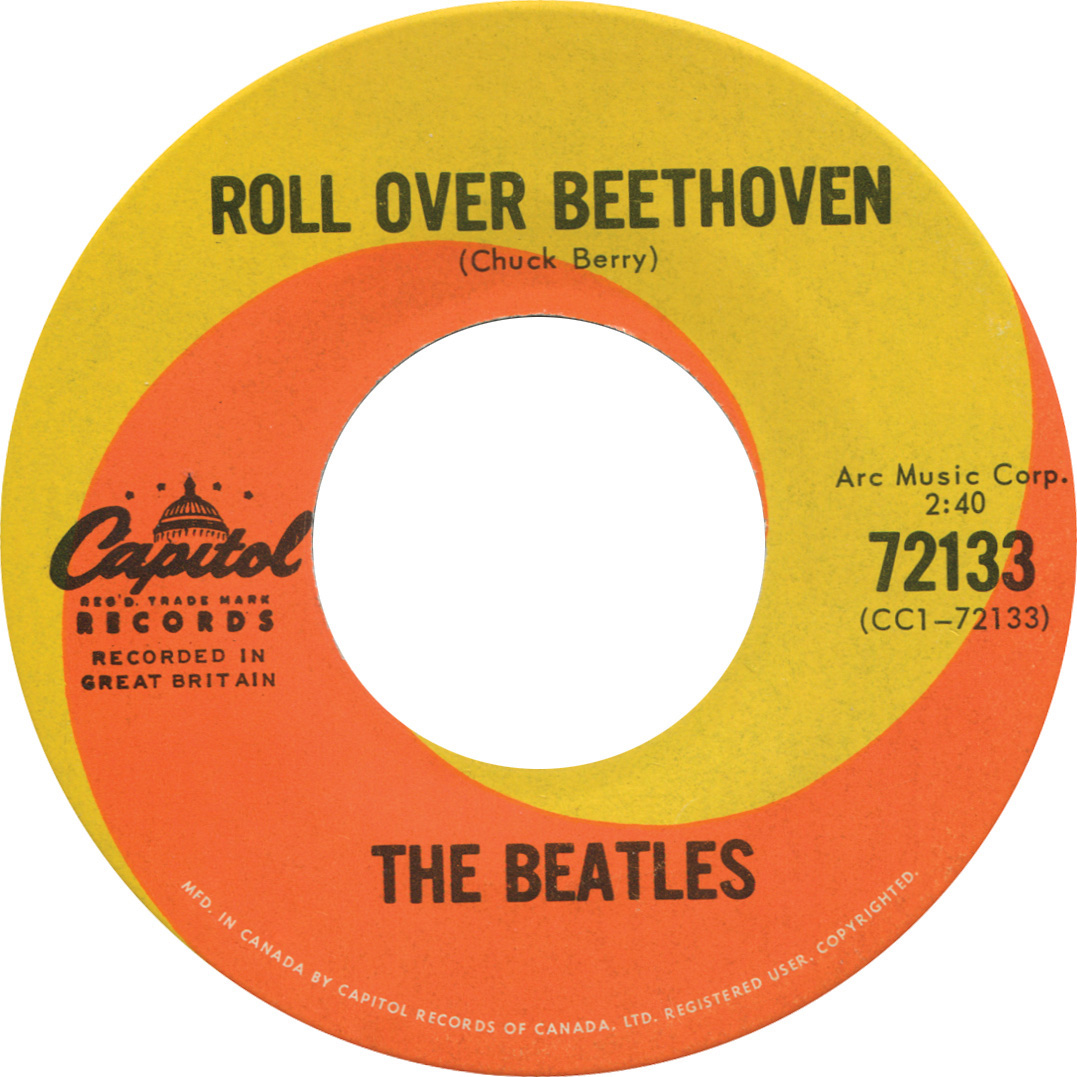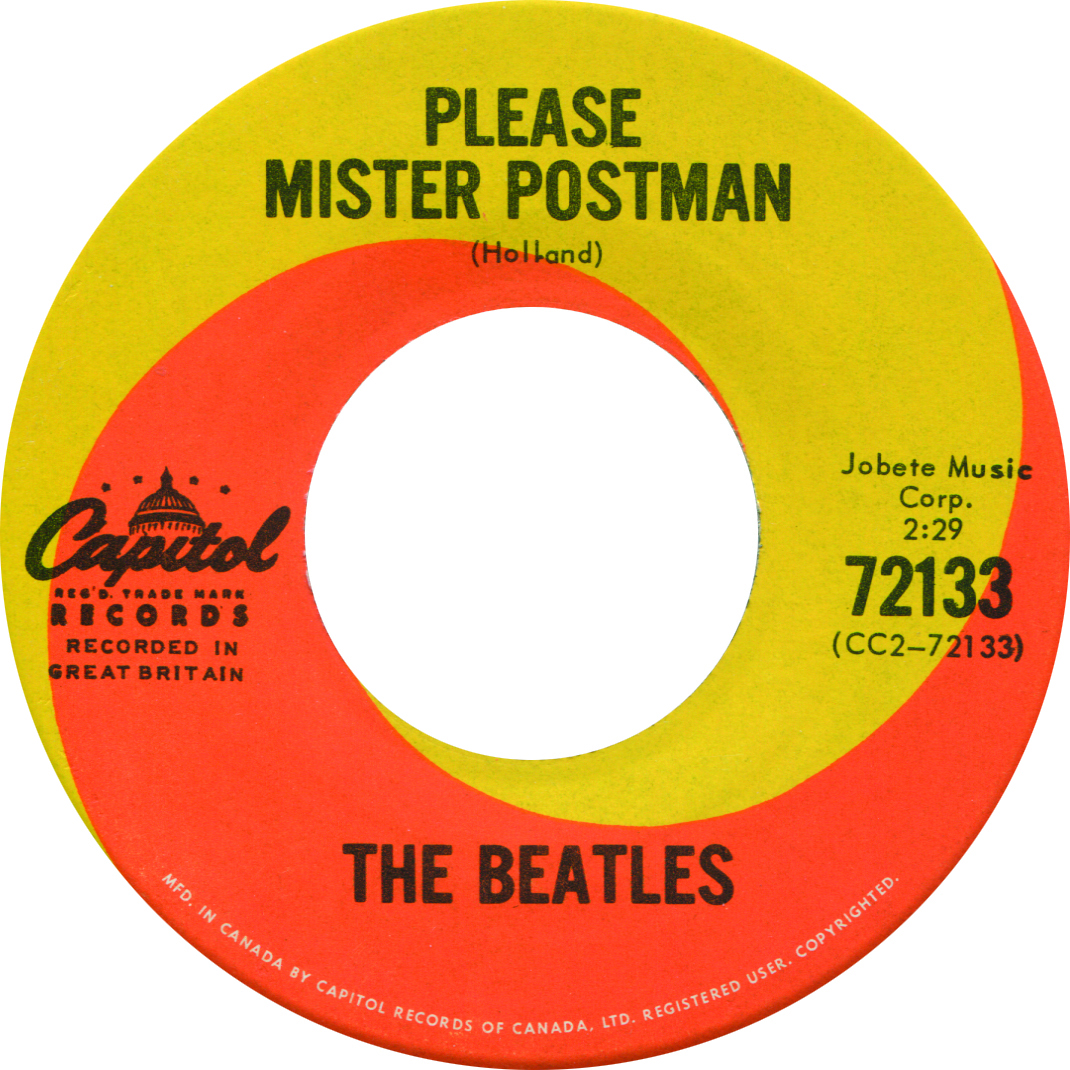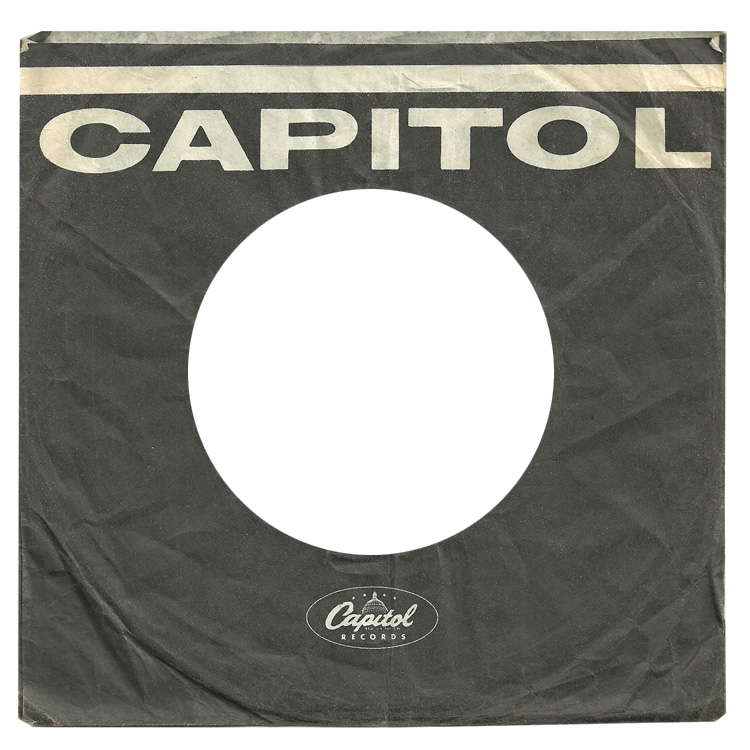← Beatles Singles Released in Canada
Roll Over Beethoven /
Please Mister Postman
45.72133.1.1 | First and only pressing - no brackets
45.72133.1.1 is the only variation of this single. It sold quite well in Canada, but was never repressed beyond the first set of releases (no copies with a -2 or higher have ever been documented). The single has been exported to the USA, but the number of copies that were pressed and exported is unclear; reported sales and exported copies do not align with matrix numbers.


Availability
This 45 RPM single was released on December 9, 1963, and remained available until stocks were depleted. Theoretically, this pressing was available until mid 1966, but considering no new lacquers were prepared, it is unclear how many copies were pressed and until when they were officially available.
General Information
Unlike the previous Canadian Capitol singles, 45.72133.1.1 was not dubbed from a UK single. This title was a Canadian creation designed to promote the new "Beatlemania!" album for the Christmas season. It was postponed from its initial intended release date of November 25, 1963 (source: P. Hemmingsen, The Beatles’ Canadian Discography part. 1).
Pressing Information
The 45 was prepared by Capitol of Canada from the UK master tapes provided for the Beatlemania album. The matrix number reads a "CC" prefix, designating "Canadian Capitol". Matrix numbers on all know copies read:
Side A: CC1 - 72133
Side B: CC2 - 72133

Reported sales and verbal recollection of pressing numbers do not match matrix number sequences, so these numbers would still need to be verified. As a reference, a stamper was reportedly capable of pressing on average up to 10 000 discs, but as a few Canadian collectors have highlighted, Canadian operations were a smaller market and had a tendency to pay extra attention to quality control and would often not "abuse" the plates until the end, but would change them earlier to ensure proper pressings.
Again, it is not known how many more copies were made from the original plates in 1963 and early 1964, but newer plates with a -2 matrix were never made, which does not match with reported sales figures of 150 000 copies in 1964. (soucre: Piers Hemmingsen's Canadian Discogaphy part 1) Any insight on this matter would be appreciated.
Packaging
45.72133.1.1 marks the first appearance of the generic THIN FLAT black Capitol sleeve:

Sales
Reported sales reached 10 000 copies in 1963 and 150 000 copies in 1964 (source: P. Hemmingsen, The Beatles’ Canadian Discography part. 3), but again, the documented matrix numbers do not match with such high reported sales figures (at 10 000 copies per stamper, one could expect 10 000 copies produced when looking at matrix numbers alone).
This record was released 3 months before the Ed Sullivan show appearance, and possibly sold moderately before early 1964. It is not impossible to consider that plates were reused in early 1964 when demand spiked when Beatlemania took off.
Another important fact to factor in was that this 45 was "heavily" exported to the USA in 1964 (along with Love Me Do and All My Loving). 350 000 copies were reportedly shipped south of the border (source: P. Hemmingsen, The Beatles’ Canadian Discography part. 3). Again, this number seems high, impossible even, when looking strictly at matrix numbers. But a few other factors need to be considered to make sense of these numbers:
A word on sales numbers and manufacturing quantities
It seems that in many cases, the logical matrix number sequences found or records do not align with reported sales (i.e., reported sales are not always consequent with numbers of manufactured copies, according to matrix information). It is believed that in the 1960s, up to 10 000 copies could be pressed from a single stamper before being worn out and replaced (and some numbers are even more conservative, at around 2000 copies).
Technically, every time a part was replaced, a dash and number were added to the matrix, indicating it was a new generation of parts. In the sense, a record would have an added "dash and number" at every 10 000 copies (if the part was good for that long). So again, following this logic, a -2 would be a record in the 10K-20K copies range, and so on. Similarly, a record sold at 100 000 copies would see masters up to approximately -10.
Reality is always a little different, and below are possible explanations why matrix numbers could be different from expected numbers, and therefore misalign with matrix numbers:
- 1. Records of sales / memory and recollections can be incomplete or skewed
- 2. Stampers broke or wore out earlier than expected
- 3. Older stampers were re-used later
Below is a representation of the different steps required to press a record. Terminology changes from one plant to another, but the gist of it remains valid:
Lacquer > Metal Master(s) (or Father) > Metal Mother(s) > Stamper(s).
The million-dollar question is "which part of the process saw an updated matrix (-2)?": The stamper? (Every 10 000 copies), the Mother (every 100 000 copies if a mother produces 10 stampers), or the lacquer producing multiple mothers? (i.e., even more identical copies).

This would imply two other possible explanations:
- 4. Matrix numbers only changed on lacquers (and therefore on the Father producing multiple mothers)
- 5. A single mother produces many IDENTICAL stampers (without no added -2 number)
These last two seem to be the most plausible explanation, especially when looking at singles with official sales figures that have kept very low matrix numbers (like All My Loving, 45.72144.1.1, for example) - this would account for higher reported numbers without having the high matrix numbers that would reflect the reported quantity of discs pressed. In any case, the sales numbers presented here do not always align with the records matrix numbers as we understand them and the various factors above need to be considered when exploring the different ranges of sales / pressed copies.